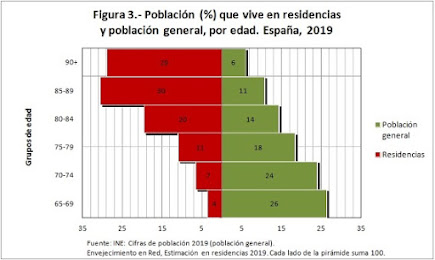Spanish nursing home industry trends after the pandeminc
The global pandemic of covid-19 is leaving behind a long trail of victims most of them among the elderly (according to data from the Spanish Ministry of Health, 80% of those who died from the virus were over 70 years old).
According to data from the Institute for the Elderly and Social Services (Imserso), there are there are 5,457 residential facilities for the elderly in Spain with 381,158 beds. 70.4% of residents are women. And 81.8% of the elderly housed in a nursing home are 80 or more years old. The coverage rate for this service is 4.21%. In other words, there are places for 4.21% of those over 65 years of age. Close to the commonly accepted recommended ratio of five places for every 100 people over 65.
Of the 5,457 centers, 1,394 are publicly owned, some of them managed by a private company, and 4,063 are privately owned. The national average shows the following balance: 74.4% of residences for the elderly in Spain are in private hands and host an average of 69.8 beds per residence. Of the total number of places, 381,158, 227,819, 59.8%, are publicly funded and the rest, 40.2%, private.
Before the pandemic, the future of the elderly residential sector was clear. The aging of the population and the increase in life expectancy predicted a rapid and long progression which involved building of new homes, consolidation and the creation of large groups dedicated to the care of the elderly, ranging from home care to nursing homes.
Some of the side effects of the pandemic have been social alarm related to nursing homes, a level of social distrust towards companies that manage them, with a corresponding reduction in occupancy, and uncertainty about the possibility of new regulations being introduced. As a result, banks have become fussier when it comes to granting loans for the construction or acquisition of homes for the elderly. Most analys coincide it is a temporary situation, but it will take up to two years to overcome.
Long-term investment and expansion plans have come to a standstill. The stock prices of large international companies have suffered losses. The three big firms in Spain are DomusVi, Orpea and Vitalia. It should not be forgotten that these large companies mange homes in several European countries (Orpea, which is listed on the Paris Stock Exchange, works in 22 countries and has more than 50 facilities in Spain, Domusvi, with French capital, is present in six countries -France, Spain, Portugal, Chile, Uruguay and Colombia- and has 156 open facilities in Spain).
What will the future be like
The Spanish nursing homes billed more than 4,500 million (data from DBK of 2018) and has received strong investments in recent years from venture capital. According to data from Aguirre Newman, until September 2019, investment in nursing homes for the elderly in Europe as a whole had reached 700 million euros. The demand for places in these residences is expected to increase by 100,000 units by 2030; In Spain, with its demographic situation, it is reasonable to think that the average coverage for people over 80 years of age, which is 13%, is close to the European average, which stands at 18%.
The pandemic effect in any given nursing home depends on multiple factors, some have hardly had any sick people and others have been severely affected. Even though investigation is required, these factors seem to be influenced by the size of the facilities, the architectural design (single or double rooms, distribution of common spaces, ease of isolating sick or suspicious people ...), the quality of care (ratio of professionals per number of inmates, their training and salaries, available material ...), and organizational issues, such as the adoption of quick and timely measures, the ability to buy protective equipment and tests. The geographical location of the home has definitely being relevant.
The truth is the nursing homes were never meant to be “small hospitals” but home substitutes. One of the questions looming over the industry is if new regulations will what them to become precisely that.
Most likely, once the pandemic is over, seeing the cost that a profound change in the requirements would have, we will return to something quite similar to the previous situation.
The demographic factor is so relevant that everything suggests that the current situation is nothing more than a bump in a clear upward line.
Findi


Comments
Post a Comment